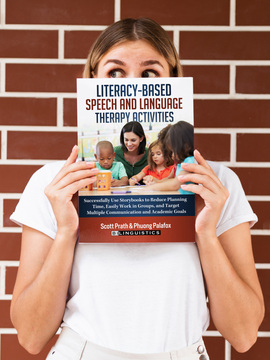We have all had difficulty motivating students or clients. We aren’t always sure why they aren’t motivated. It can be due to embarrassment about their speech, low self-esteem, or simply not wanting to do what you are asking. But we know that they are not progressing or learning when we can’t get them to do what we are suggesting.
Luckily for us, there are very strong connections between motivating students and executive function. For those of us in speech language pathology, this means that we have powerful information at our fingertips that we can share with parents and teachers or use to have amazing speech therapy sessions.

Let’s begin by taking a look at an example from outside academics.
A child obsessed with winning a video game to defeat his brother needs to employ all of his executive functions. He watches his brother play the game all weekend with all the excitement around the victories, bells, and whistles.
On Monday, when his brother leaves for school and he finally has access to the game, he has to work slowly and methodically, learning all of the different fine motor movements. He has to sit still and focus for multiple hours. He is cognizant of the time because he only has until 2:30 when his brother comes home.
By Tuesday he is repeating levels multiple times and practicing over-and-over until he is proficient. He denies himself his snack and nap for the later reward of getting to the next level. By Thursday, the speed of his thinking and fine motor movements have increased. At this point, his thinking leaves the frontal lobe because the skills needed are now automatic. His mind is now free to strategize and think deeply about how to get to the next level and improve his score.
By Friday he settles in as soon as the bus leaves. He has to review and redouble his efforts because tomorrow is the final exam. Can he beat his brother? He smiles with determination.
What’s Going on with Unmotivated Students?
Successfully motivated students are able to disengage from their own reward centers and attend to yours. In order to do this, they need to identify an overall goal that is pleasing to them.
Our brain has a system of rules it follows which allows us to stay motivated and achieve our goal.
This Internal Command Pathway is set up so that we have a framework to get what we want. We see the value of a long-term goal and are determined to get there. We remain continually motivated and thereby improve.
However, education is not set up this way. We are continually asking students to do what we want.
Successful students are able to disengage from their own reward centers and attend to yours. In order to do this, they need to identify an overall goal that is pleasing to them. As educators, we know this and can motivate the average students with systems of rewards and punishment.
Children with executive functioning deficits struggle to disengage from their own internal command pathway so we need strategies to help them get there.
These strategies:
- Increase Motivation – Desire
- Increase Self-Determination – Our ability to make choices based on personal preference
Motivation and Self-Determination
Motivation
Motivation is what causes us to act. It is the reason we eat, seek out a friend, or complete our homework. Motivation initiates, guides, and maintains goal-oriented behaviors.
Motivation involves the biological, emotional, social, and cognitive forces that activate behavior. In everyday usage, the term motivation is frequently used to describe why a person does something. Typically, we don’t tend to think about “why” a student does what they should because for most students they do what is expected of them rapidly dozens of times each day. However, a motivation does exist to act. It is more often that we spend time on why a student will not act. It’s with these students that we may have to provide a better motivation.
Self-Determination
Self-determination leads a person to make choices and decisions based on their own preferences and interests, to monitor and regulate their own actions and to be goal-oriented and self-directing.
A self-determined brain will say. I have to do this because I want this outcome down the road. Knowing that goal helps us power through the times that we are less motivated or do not enjoy the task and the brain has to say, “I really need to regulate here to get the outcome that I want.” “I really need set down my phone and get this report written!”
Without self-determination – without seeing the point, it is hard to self-regulate.
Self-determination is different from self-regulation but they are intertwined. You can self-regulate throughout the day staying calm, sitting, be where you need to be and still accomplish next to nothing. Self-determination guides our behaviors so that we can get done what we need to because we know how it relates to the bigger picture. What is it that you want to achieve? Why is it important?
Strategy: Motivating students with conversations that hook the brain
Strategies that focus on executive function are teaching a student how to disengage from their own reward system, tune in to yours, and find a reason to motive themselves to work towards a goal. Research studies have shown that by “hooking” a child with enticing phrases immediately changes their outlook on the situation. Examples of this can be:
- This is going to be fun.
- Let’s play a game.
- You actually like doing this.
- You are good at this.
In studies where these phrases were implemented before a task, students spent more time working on the task and were more successful completing the task. This occurred when the tasks were identical and even if the hooking statement was not entirely true. For example, students completed math problems more effectively after hearing “this is going to be fun” even when there is nothing inherently fun about the task.
Daniel Pink refers to this phenomenon as “the Sawyer Effect” in his book {LINL} Drive: The Surprising Truth About What Motivates Us. Tom Sawyer not only convinces his friends to paint his fence but is gets them to the point that they are begging him to help and actually pay him to participate.
Let’s Review
There are very strong connections between motivation and executive function. If students are not motivated to take on the hard work that is required in school, it is very difficult for them to activate their executive functions.
Secondly, self-regulation is dependent on self-determination.
If you have difficulty implementing strategies for executive function, take a step back and ask: Is this student motivated? Does he know how this applies to him and does he know the reason “why” he is doing this? Have I related the reason why he doing this to his own personal goal?
Apply Easily Motivational Interviewing Strategies to Your Caseload
If you want more information on motivating students, how to help your students regulate emotions, and follow through with what you are teaching, join us inside SLPImpact and also get CEUs.
Increasing Client Motivation and Self-Direction: Executive Function 201
Strategies for executive function can be incredibly successful but there are a number of students who still have no success despite multiple interventions. This course presented strategies and interventions for when students are not motivated to perform a task and don’t understand why they should learning something new.
Read more:
5 Part Executive Function Series
Part 1: Executive Function in Speech Therapy – What is Our Role as SLPs?
Part 2: Building Student Executive Functioning Skills
Part 3: 9 Ways Executive Function Affects Learning
Part 4: Executive Functions of the Brain – Understand This and Understand Your Students
And a Bonus!: Helping When Children with Executive Function Difficulties Have Additional Diagnoses






